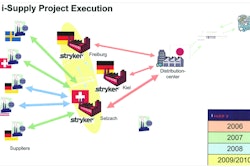New York—August 19, 2015—Especially in the wake of China’s recent devaluation of the yuan, companies need to be more strategic than ever in their manufacturing-sourcing decision-making, focusing on clear-headed, case-by-case analysis and tight project management. That’s according to a new study, including a survey of almost 250 senior-level executives in North America and western Europe from manufacturing and distribution companies across 15 broad industry groups, released today by AlixPartners, the global business advisory firm.
The AlixPartners study finds a continued appetite for nearshoring—i.e., moving production near, or to, its ultimate end-market. A total of 32 percent of the executives in North America (the U.S. and Canada) and western Europe say that their companies recently nearshored manufacturing production or are in the process of doing so, with 40 percent of North American business leaders saying so.
Meanwhile, among North American respondents, 55 percent cite the U.S. as the most attractive nearshoring destination, up from 42 percent in last year’s survey, when the U.S. placed No. 1 for the first time. Mexico—long the nearshoring favorite in this survey—came in second, at 31 percent, up as well from last year’s survey (28 percent), but down dramatically from 49 percent in the AlixPartners survey of just three years ago.
One potential reason for the fluctuation in the outlook toward Mexico could be a lack of certainty regarding safety and security issues. According to the survey, only 42 percent of North American respondents expect improvement in those areas in Mexico, down from 55 percent in last year’s survey.
By comparison, 61 percent of European business leaders in the survey say they expect an improvement in safety and security in eastern Europe, their top preferred nearshoring destination (chosen by 38 percent of respondents vs. 16 percent for western Europe, 15 percent for Turkey, 7 percent for North Africa and 6 percent for the Middle East).
With issues like safety and security complicating the nearshoring picture, it’s perhaps not surprising that the survey finds what appears to be less urgency for nearshoring today than in the past. According to the poll, only 21 percent of North American and European executives say that nearshoring decisions are more important now than a year ago—though 76 percent say such decisions are about the same in importance as a year ago, with 82 percent of North American respondents saying so.
The availability of skilled labor further complicates nearshoring decisions today, says the survey. In fact, that was the No. 1 challenge cited by both North American and European respondents, with 48 percent of Europeans and 42 percent of North Americans pointing to it, up from 33 percent in last year’s survey for the latter.
Other challenges near the top of the list: maintaining product quality (cited by 38 percent of respondents overall and 33 percent of North Americans), working through local government regulations (32 percent overall and 27 percent of North Americans) and personnel-management and labor-law issues (26 percent overall and 24 percent of North Americans).
However, the AlixPartners study also suggests that the benefits of properly addressing and working through nearshoring issues can be great. According to the survey, the average estimated savings from nearshoring cited by all respondents was 8.5 percent, with 13 percent saying they expect to save 20 percent or more. Among North American respondents, the average estimated savings was 8.3 percent, up from 6.4 percent in last year’s survey.
Foster Finley, managing director at AlixPartners and head of the firm’s operations practice in the Americas, says: “Recent moves by China to devalue the yuan make already-complex manufacturing-sourcing decisions all the more complicated. These actions prove, as do what I’ll call the nuanced results in our survey, that the world of manufacturing and supply chains is a world of constant flux, and that, in such a world, there’s no substitute for deep, strategic, case-by-case analysis and tight project management.”
The AlixPartners Strategic Manufacturing-Sourcing Outlook analyzed manufacturing sourcing costs, patterns and expectations related to meeting local-market demand. The study included an online survey, conducted in June 2015, of 248 senior-level executives from manufacturing and distribution businesses across 15 broad industry groups. Among the companies represented in the survey, 92 percent had annual revenues of $100 million or more, with 69 percent having revenues of $1 billion or more and 32 percent having revenues of $10 billion or more. All of the respondents said that they sourced production across multiple continents, averaging about 10 production locations per company to supply their domestic end-customers.


















